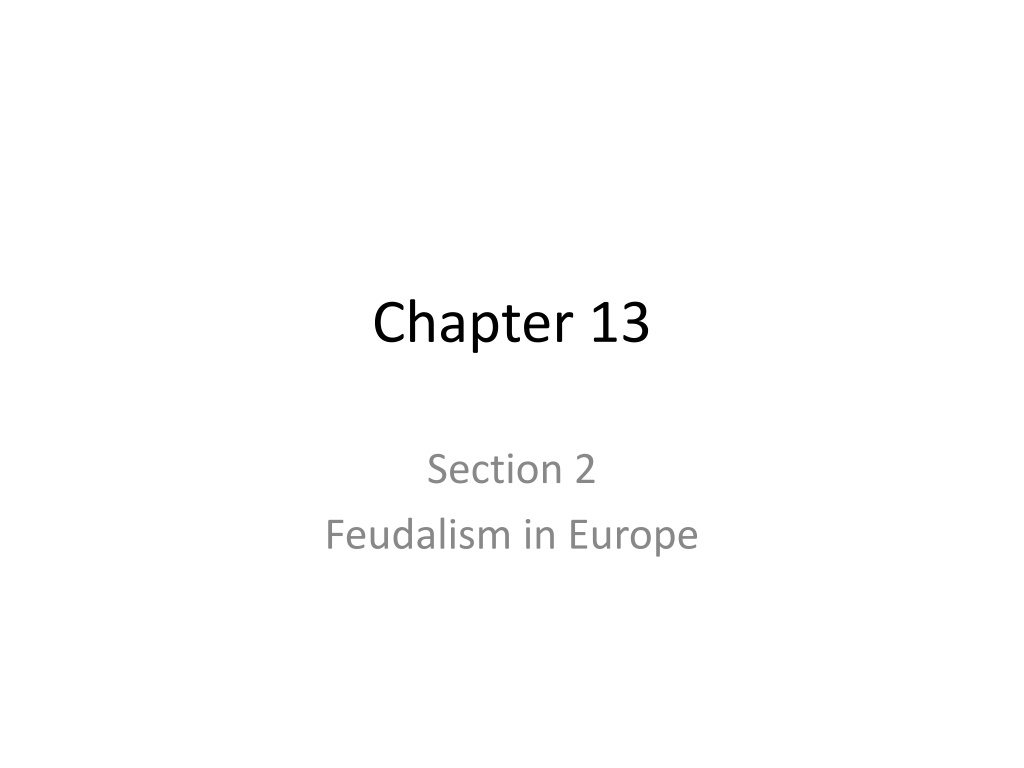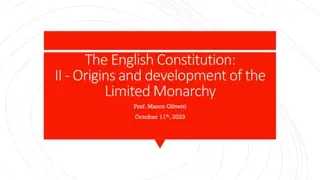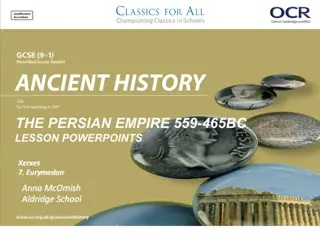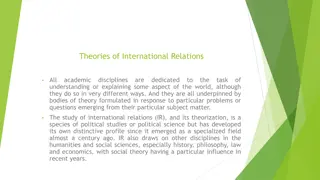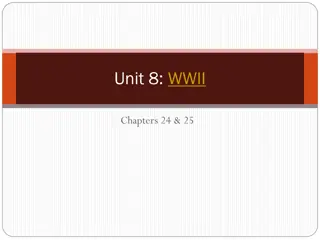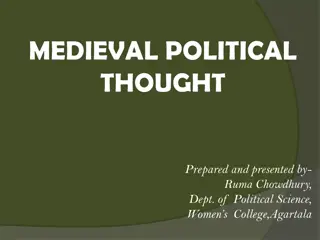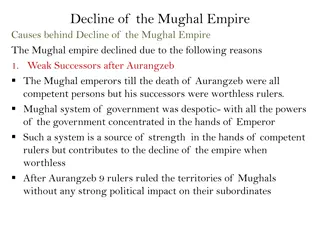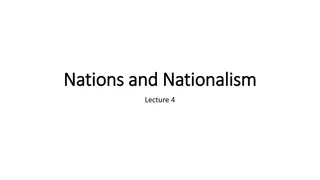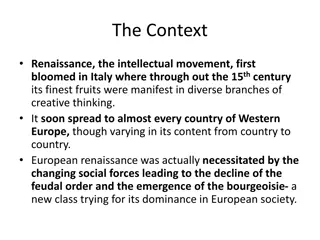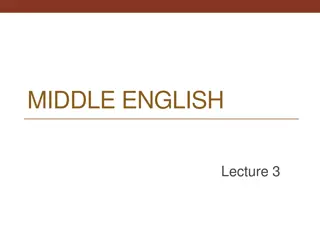Feudalism in Europe: New Invasions and the Emergence of Feudalism
New invasions by Vikings, Magyars, and Muslims brought chaos to Western Europe, leading to the decline of central authority. Feudalism emerged as a system of governing and landowning, based on mutual obligations between lords and vassals. The Feudal Pyramid structured society, with kings at the peak and knights defending their lords' lands.
Download Presentation

Please find below an Image/Link to download the presentation.
The content on the website is provided AS IS for your information and personal use only. It may not be sold, licensed, or shared on other websites without obtaining consent from the author. Download presentation by click this link. If you encounter any issues during the download, it is possible that the publisher has removed the file from their server.
E N D
Presentation Transcript
Chapter 13 Section 2 Feudalism in Europe
New invasions Trouble Western Europe Invasion completely destroyed the Carolingian Empire Muslims seized Sicily and raided Italy eventually sacking Rome Magyars terrorized Germany and Italy From the north the most dreaded attackers of all - Vikings Vikings: Raiders, Traders, and Explorers Vikings sail from a cold, wooded region Scandinavia Called Northmen or Norsemen
Worshiped warlike gods Carried out raids with terrifying speed Viking warships were awesome - help up to 300 warriors Not only warriors but traders, farmers, and outstanding explorers Viking explorer, Leif Ericson most likely reached North America are 1000 About that time Viking terror in Europe faded away They gradually accepted Christianity and began creating agricultural settlements in Iceland and Greenland
Magyars and Muslims As Viking attacks declined the Magyars began attacking from the east Superb horseback riders Invaded western Europe around 800 not there to conquer land but sell conquered ppl into slavery Muslims began attacking from the East Tried to conquer and settle Europe 600 s -700 800 s 900 their goal was to plunder These attacks caused widespread disorder Most Europeans lived in constant danger, central authority proved useless Began looking to local rulers for security
Feudalism Structures Society Viking Chief Rollo and Charles the Simple, King of France, former enemies met in a peace ceremony Charles granted Rollo French territory, and Rollo swore a pledge of loyalty in return A new Social Order 850 950, worst years of invading attacks Ruler and Warriors made agreement all over Europe System of governing and landowning called feudalism had emerged in Europe
Based on mutual obligations Exchange for military protection and other services, a lord, granted land called a fief The person receiving a fief was called a vassal The Feudal Pyramid Peak was the King Next powerful vassals wealthy landowners like nobles and bishops Beneath Vassals were knights Knights mounted warriors who pledged to defend their lords land in exchange for fiefs Base landless peasants who toiled the fields
In practice the feudal system did not work so simply Relationships between lords and vassals were never clear cut Feudal pyramid became complex tangle with conflicting loyalties each using them to their own advantage Social Classes Are Well Defined Status determined a person prestige and power Social class was usually inherited Vast majority of people were peasants most peasants were serf Serfs could not lawfully leave the place they were born
Manors: The Economic Side of Feudalism Manor the lords estate Manor system was a basic economic agreement Rested on a set of rights and obligations between a lord and his serf Lord provided the serf with housing, strips of farmland, and protection from bandits Serfs tended the lords lands, cared for his animals, performed other tasks to maintain the estate
A Self Contained World A lords manor usually consisted of a manor house, a church and workshops 15 to 30 families lived on the manor Fields, pastures and forests surrounded the village Streams and ponds provided fish, an important food source
The Harshness of Manor Life Peasants paid a high price for living on the lords land Taxes on all grain ground at the mill, tax on marriage Trying to dodge these taxes was treaded as a crime Paid a tithe, or church tax, 10% of their income Serfs lived in small huts with dirt floors, bringing in pigs to warm the house at night and sleeping on a pile of straw
Chapter 13 Section 3 The Age of Chivalry
Warriors on Horseback Mounted soldiers became valuable during Charlemagne reign Charles Martel observed the Muslim cavalry He organized Frankish troops of armored horsemen, or knights The Warrior s Role in Feudal Society 11thcentury, western Europe was a battleground of warring nobles Lords raised private armies, rewarding knights with fiefs Fiefs allowed knights to devote their lives to war Obligation was to serve 40 days in battle a year
Knighthood and Chivalry Knights were expected to display courage in battle and loyalty to their lord Chivalry a complex set of ideals, demanded a knight fight bravely in defense of his three masters Earthly feudal lord Heavenly Lord His chosen lady
War Games and Glory Knights took part in mock battles called tournaments Trumpets blared, lords and ladies cheered Tournaments were fierce and bloody competitions Brutal reality of Warfare Castles dominated the countryside in Western Europe Castle was home of the lord and lady, their family, knights and servants Also a fortress designed for defense
Attacking armies used various strategies to force the defenders to surrender Defenders poured boiling water, hot oil, or molten led on enemy soldiers The literature of Chivalry Themes of medieval literature downplayed the brutality of warfare Songs and poems about a knights undying love for a lady were also popular
Epic Poetry Epic retold stored about legendary heroes of the middle ages like King Arthur and Charlemagne The Song of Roland one of the earliest and most famous medieval poems Praises French soldiers who perished fighting a Muslim invasion
Love Poems and Songs A knights duty to his lady was just as important than the duty to his lord Troubadours poet- musicians at the castles and courts in Europe Composed short verses and songs about the joys and sorrows of romantic love
The Shifting Roles of Women Church viewed women as inferior The idea of romantic love placed noblewomen on a pedestal A true knight pledged to protect all women As feudalism developed the women s role declined Most women were poor and powerless Confined to performing endless labor, bearing children and taking care of the family
Women in Power In the feudal system a noblewomen could inherit an estate from her husband Send knights to war and act as a military commander if her husband was away Women s Failing Status As the middle ages progressed, noblewomen had less power Eleanor of Aquitaine was an exception As queen of England she would rule when her husband Henry II was away and even later for her sons
